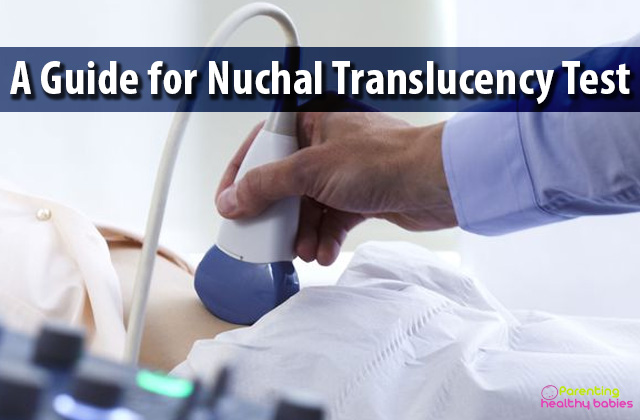If you are an expecting mom-to-be, suggestions about how best to handle your pregnancy must be pouring in from your loved ones. Chances are, you must have already heard of a nuchal translucency test. There are so many tests and appointments that you will have to attend in the course of your pregnancy. One of them must be the nuchal translucency test. It is a very important ultrasound test that must be paid utmost attention.
The nuchal translucency test or scan, which is also known as the NT scan uses ultrasound to assess your developing baby’s risk of having Down syndrome (DS) and some other chromosomal abnormalities, as well as major congenital heart problems.
What is the nuchal translucency test?
The nuchal translucency scan or NT scan measures the clear (translucent) space in the tissue at the back of your child’s neck. Babies with abnormalities have been seen to accumulate more fluid at the back of their neck during the first trimester, which causes this clear space to be larger than normal. The NT scan is a regular scan and is non-invasive in nature.
Which week of pregnancy is nuchal translucency test done?
The NT scan must be done between 11 to 14 weeks of pregnancy, because this is when the base of the baby’s neck is still transparent (the last day you can have it is the day you turn 13 weeks and 6 days pregnant). The nuchal translucency scan is a common feature along with blood tests in first trimester combined screening and testing programmes.
Sometimes your practitioner might look for a nasal bone in your pregnant baby. Some experts believe that the absence of a nasal bone in the fetus is a sign of chromosomal abnormality.
However, you must know that the NT scan does not provide a diagnosis. The scan can only estimate the likelihood of your baby developing certain problems and help you make a decision about whether or not to take additional tests to find out whether your baby is really affected. You can also wait for more tests and give it a little time- maybe till you reach the second trimester, before deciding on taking additional tests to see if your baby is affected or not.
The NT scan is a must for all pregnant women in the first trimester. Most maternity clinics offer this scan.
What are the advantages of getting the nuchal translucency test done?
Any test done during the first trimester gives you the advantage of learning more about abnormalities and conditions that your baby may develop, quite early-on during the pregnancy. This gives you the option to freely choose and decide what tests are most suitable for your next trimesters, based on these results. Additionally, the NT scan, being non-invasive, helps you be free from the risks of an invasive test.
How to decide on what tests based on the results of an NT scan?
Experts are of the view that all women be offered the chance to get the nuchal translucency test done in their first trimester. Many women choose to take this test so that they can decide what tests to take further, based on the results of this one.
Most women opt for screening and then make a decision about diagnostic testing (meaning CVS or amniocentesis) based on the initial results. Other women opt for diagnostic testing without screening first; they may know that they’re at high risk for a baby with a chromosomal problem or a problem that can’t be detected by screenings.
How is the nuchal translucency test done?
The process of the NT test is similar to a normal ultrasound. The sonographer first confirms your baby’s gestational age by measuring him/her from crown to rump to ensure he/she is about the correct size for his/her age. Then she positions the sensor or transducer over your abdomen so that your baby’s nuchal translucency is displayed on the monitor and measures the thickness of it on the screen with calipers.
How are the scan results calculated?
Your baby’s likelihood of having a chromosomal abnormality are determined by the nuchal translucency measurement, your age, your baby’s gestational age and the blood test results.
Age is a factor here because although anyone can have a baby with a chromosomal abnormality, the risk increases with age. For example, your likelihood of carrying a baby with Down syndrome ranges from approximately 1 in 1,200 at age 25 to 1 in 100 at age 40.
Because a baby’s nuchal translucency normally gets a bit thicker with each day of gestation, researchers have been able to establish how large the translucent area should be each day during the initial weeks that the screening can be performed.
Experts have also calculated the statistical relationship between this measurement, the baby’s age, the mother’s age, and the chances that the baby will be born with certain abnormalities. Basically, the thicker the nuchal translucency at a given gestational age, the higher the chance of a chromosomal problem.
What do my NT scan results mean?
The results are normally in a ratio that expresses the chances of your baby having a chromosomal abnormality. For example, you may be told that your baby’s chances of having Down syndrome are 1 in 30 or 1 in 4,000. A risk of 1 in 30 means that for every 30 women with this same result, one baby will have Down syndrome and 29 will not. A risk of 1 in 4,000 means that for every 4,000 women with this result, one baby will have it and 3,999 will not. The higher the second number, the lower the risk.
You may also be told that your results are “normal” or “abnormal,” depending on whether they are below or above a specified cutoff. For example, some tests use a cutoff of 1 in 250. So a result of 1 in 4,000 would be considered normal because the risk that there’s a problem is lower than 1 in 250. A ratio of 1 in 30 would be considered abnormal because that risk is higher than 1 in 250.
You have to decide on your further course of action based on these results.
Read More: 11 Benefits of Getting an Ultrasound During Pregnancy
How accurate are these results?
Screening tests aren’t fully accurate, but their margin of error isn’t very large.
They don’t detect all cases of Down syndrome, so they may identify your baby as being at low risk when she really does have Down syndrome. This is called a false negative result, and it might lead you to choose to not go for diagnostic testing that would have revealed a problem.
At the same time, screening may identify your baby as being at high risk when she is fine (a false positive). This may cause you to undergo further testing and to worry about your baby’s well-being unnecessarily.
The NT scan alone will detect about 70 to 80 percent of babies with Down syndrome (depending on which study you look at). The detection rate for the NT scan plus a first-trimester blood test ranges from 79 to 90 percent.
Therefore, an NT scan is must if you want to detect chromosomal abnormalities in your baby, early on in your pregnancy.
Read More: 21 Tricks To Decoding An Ultrasound
References
https://www.webmd.com/baby/first-trimester-screening-nuchal-translucency-blood-test













